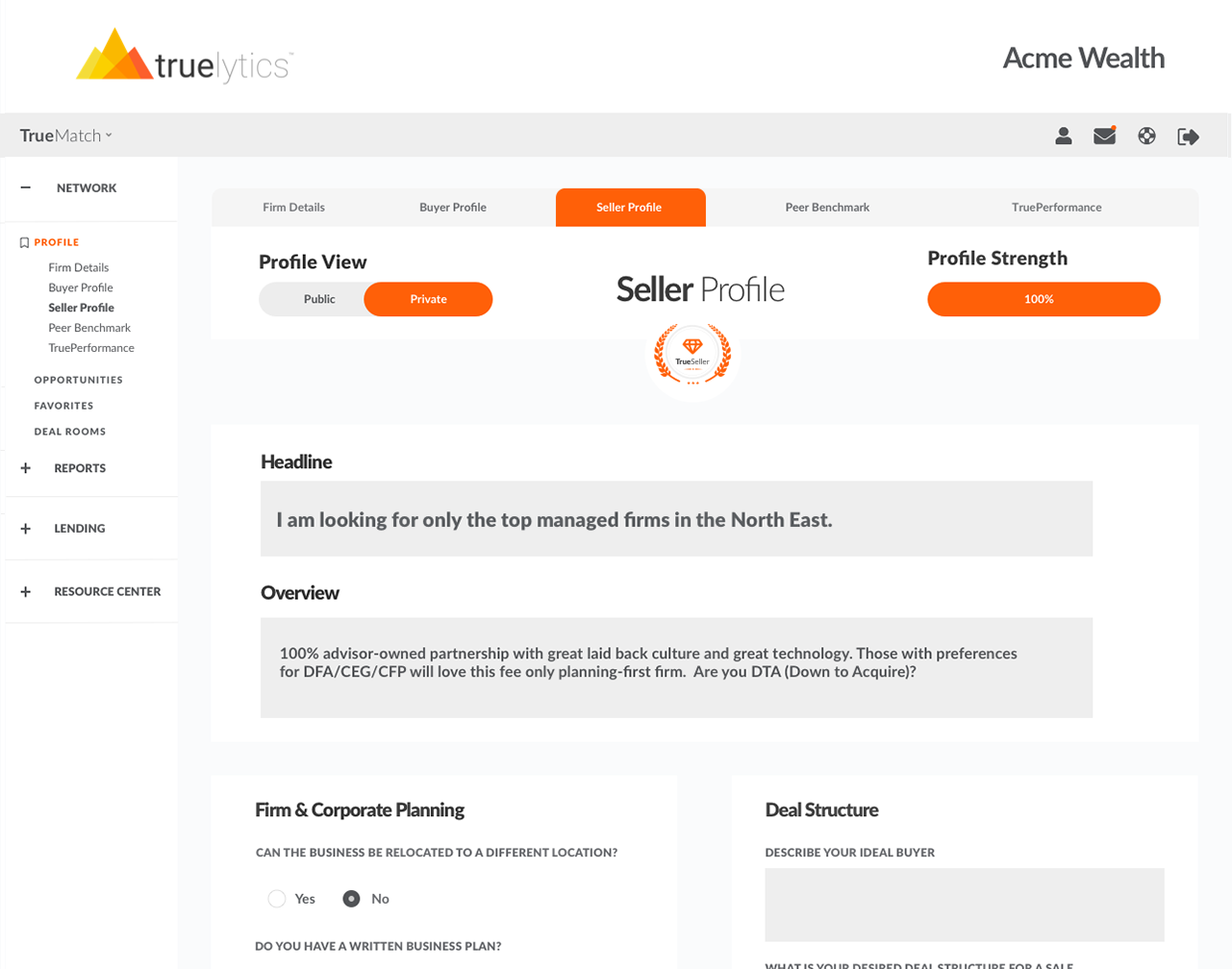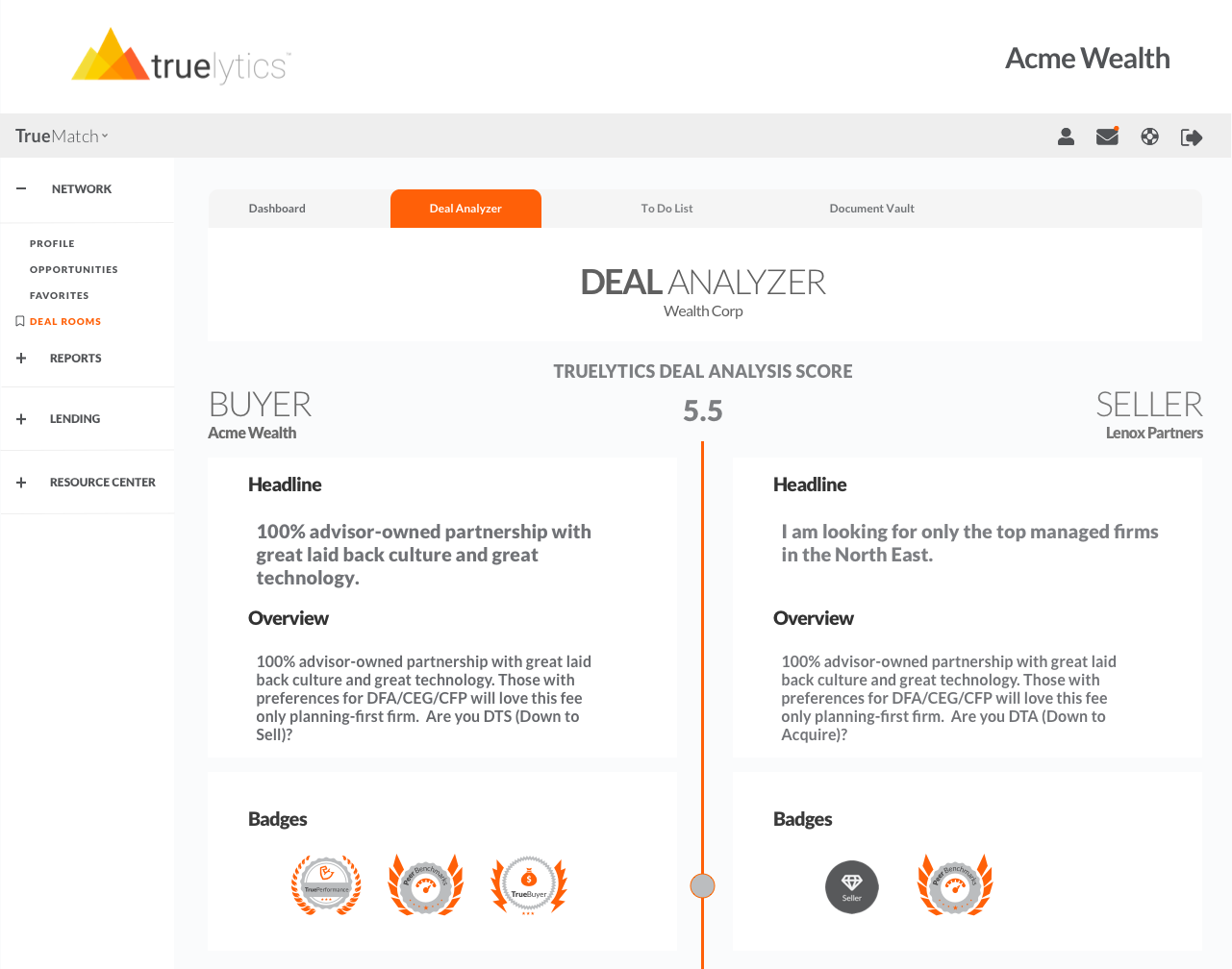
Truelytics is pleased to announce the fourth and final piece of our Advisor Transition Management Solution – TrueMatch
As I’m sure many of you are aware of, buyer-seller marketplaces aren’t anything new for the advisor industry. There are plenty of sites where thousands of buyers get open access to spam the inboxes of the significantly fewer sellers in the marketplace; never mind if there’s a solid match there or not. The marketplace doesn't necessarily care if this is good for the seller or not. As long as a transaction happens in the end (and the marketplace gets a cut of the transaction), everyone wins, right? Wrong!
The TrueMatch approach to matchmaking is different.
Before we jump into all the goodies that TrueMatch has to offer that go above and beyond your typical marketplace offering, let’s get the basics out of the way. Much like other marketplaces out there, TrueMatch offers:
Now that the basics are out of the way, let’s jump into the fun stuff.
TrueMatch is not a single marketplace. Rather, it’s a series of separate marketplaces -- a series of islands! Each island has its own rules and regulations.
Why does this matter? Because instead of Truelytics coming up with the one-size-fits-all approach to matchmaking, we allow each marketplace to be customized to meet specific needs to specific groups of people -- or should I say, specific island populations, to keep the analogy going.
Public marketplaces allow anyone to join and participate. The potential for growth is obvious, as users can sign up, join the marketplace, fill out the profile, and start making use of the platform.
Private marketplaces, on the other hand, are closed and are by invitation only. Private marketplaces are especially useful for internal transitions, such as M&A events happening within a broker dealer. Private marketplaces are also quite useful for protecting their participants. Even within an organization, some firms are good candidates for a matchmaking process, and some aren’t. With private marketplaces, the marketplace owners can decide who’s allowed in and under what conditions.
As mentioned above, sellers are a hot commodity in matchmaking. There are many more buyers than sellers -- that’s just a fact that we need to recognize (instead of sweeping it under the rug like we’ve seen other marketplaces do). As such, many sellers are reluctant to put themselves in marketplaces for fear of getting inundated with messages from unqualified buyers that are taking the shotgun approach to buying.
Our marketplaces have the option to put bodyguards in place to act as an intermediary between the buyer and the seller. When a buyer attempts to connect with a seller, the connection must first be approved by a marketplace administrator. The administrators can see all of the anonymous details that the normal participants can see, plus contact details and other details that the participants share with the marketplace administrators that help decide if they should allow this invitation to make it to the invitee. Why does this matter? If you have sellers who are reluctant to join a marketplace, for fear of being contacted by too many buyers, you can add in this layer of added security to make sure they feel safe. Like a bodyguard… get it?
TrueMatch comes with a pre-configured intake form for buyers and sellers. We made the calls, did the research, had the interviews, and came up with what we think is a very compelling set of questions to ask buyers and sellers. However, we’re not as arrogant to think that we nailed the process for everyone’s needs. That’s why our intake forms are 100% configurable. Enterprises can change a question here or there, or completely wipe the pre-configured forms and replace it with their own special sauce.

With all of these custom profiles and custom profile types, how can TrueMatch know if a buyer and a seller are a good match? The short answer is, we can’t! That’s why we’ve created the Deal Analyzer that allows a marketplace to be configured to show the strength of each match. You can take answers from one side of the match (e.g., the buyer) and compare them with answers to the other side of the match (e.g., the seller) and award points and priority to each of the criteria to help surface good match opportunities.

Using this information, buyers and sellers and any other profile type in our system can assess the match strength before reaching out. In future versions of TrueMatch, we’ll even allow the marketplace to be configured to disallow reaching out if certain match criteria aren’t met.
This is one of the biggest differences between TrueMatch and other marketplaces out there today. Matchmaking, in our humble opinion, isn’t only about matching people looking to buy a business with people looking to sell a business. Sometimes you’re looking for a business partner or a merger. Sometimes you’re looking to add new advisors to your firm. Sometimes you’re looking for a succession partner for unplanned succession. Sometimes you are running a lifestyle business and just have a book of business that you want to sell without having to answer all those fancy questions about your business processes and infrastructure. Sometimes you’re looking for a new technology vendor. In short: there are lots of different types of matches you’re trying to make in your business.
Well… TrueMatch has all of that covered!
At the core of TrueMatch is one truth: a true match requires two sides to come together. That’s it! What that means for TrueMatch is that, for any given profile type (e.g., Buyer), there’s at least one other profile type (e.g., Seller, Book of Business) that matches to it.
From there, different rules can be applied to each profile type and to each two-sided relationship, such as:




When you think of matchmaking, I’m sure you think about video games, right? Maybe not… but let me explain. The same technology used to go into the Deal Analyzer can also be used for two other “gamification” features in TrueMatch: Opportunity Badges and Opportunity Quality. They’re fairly similar in concept, but play into the platform quite differently. Opportunity Badges offer a public display of completeness, strength, or unique qualities that the marketplace can configure to help opportunities stand out when viewed in the Opportunity List or in the Opportunity Profile. Opportunity Quality, then, is used to help surface the most qualified and quality opportunities to the top of the list -- like google’s search result algorithm. The combination of these features gives TrueMatch a high level of customization to further help opportunities find each other.
Finding the right opportunities is how it all starts. But then it’s time for the match to start “dating.” This is where our Deal Rooms come into play.

A deal room is a safe communication space for both parties to communicate and share information. Both parties start anonymous and, at any point, can choose to share more information with each other. If things are going nowhere, the deal room can be closed by either side, and all data goes back to anonymous.
In the end, our goal with TrueMatch is to have a transparent matchmaking process. Our goal isn’t to cause as many transactions as possible. Our goal is to cause the right transactions at the right time. As such, we give our marketplace users as much information as possible to help them make their decision. When viewing opportunities, we show:
This might sound like a “no duh” feature, since TrueMatch is a part of the Truelytics platform, but we think it’s important to point out. Because TrueMatch is a part of the Truelytics platform and lives within the same product ecosystem, TrueMatch benefits from all of the Truelytics features that no other matchmaking platform can offer... ever! Features such as:
So there you have it! The essence of TrueMatch distilled down into a blog post.
Our hope is that TrueMatch creates an entirely new expectation in how online two-sided marketplaces work within the wealth management industry. One based on robust and data-driven profiles; matchmaking algorithms that reward active users of the system and discourages those who simply seek to game it; security and privacy for both buyers and sellers; public or private options; and enterprise customization and governance.
As always, if you think there’s something that you’d like to see, please feel free to reach out and let us know.
These Stories on Product Release Notes